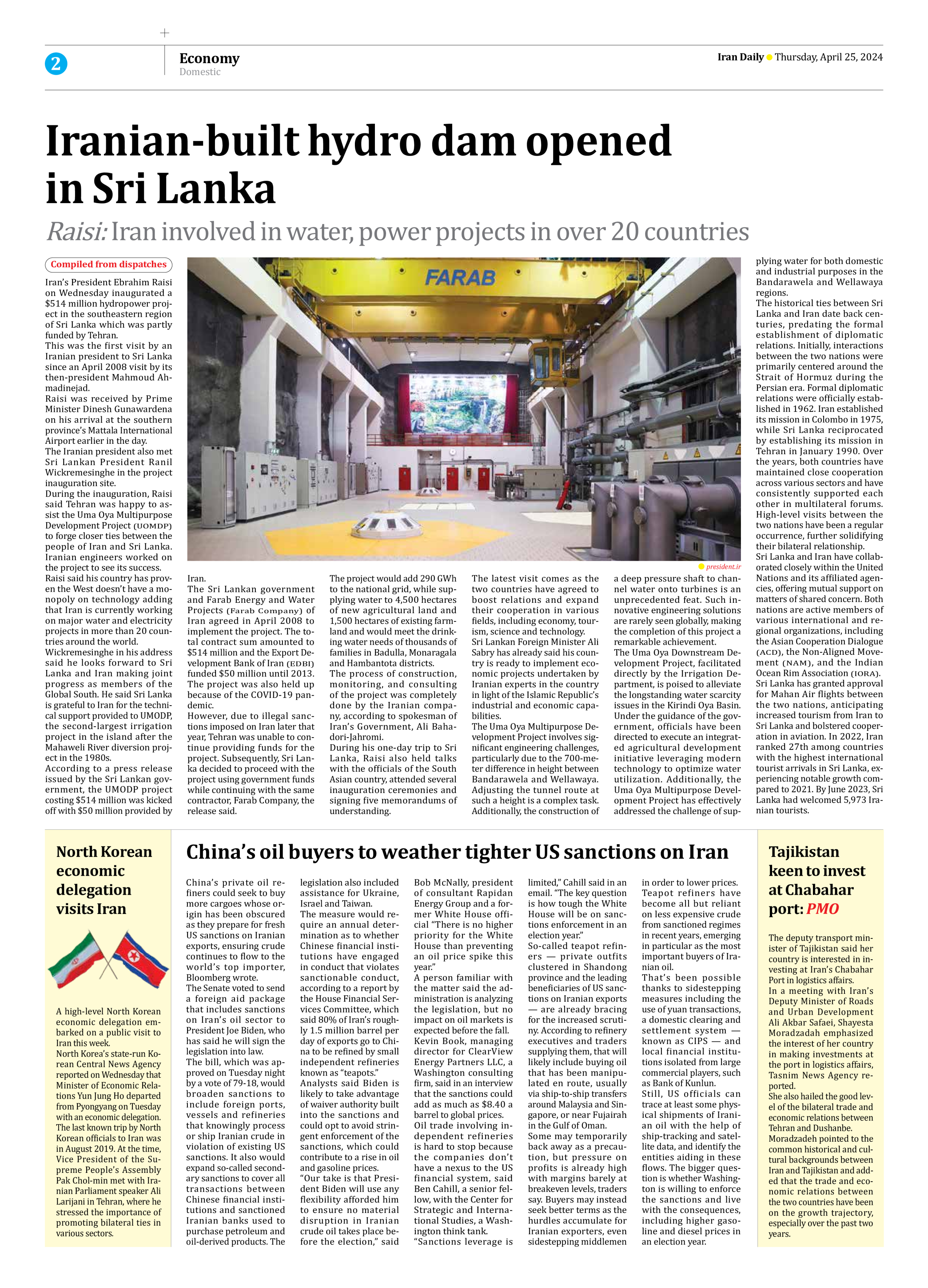
Copy in clipboard...
Iranian-built hydro dam opened in Sri Lanka
Raisi: Iran involved in water, power projects in over 20 countries
This was the first visit by an Iranian president to Sri Lanka since an April 2008 visit by its then-president Mahmoud Ahmadinejad.
Raisi was received by Prime Minister Dinesh Gunawardena on his arrival at the southern province’s Mattala International Airport earlier in the day.
The Iranian president also met Sri Lankan President Ranil Wickremesinghe in the project inauguration site.
During the inauguration, Raisi said Tehran was happy to assist the Uma Oya Multipurpose Development Project (UOMDP) to forge closer ties between the people of Iran and Sri Lanka. Iranian engineers worked on the project to see its success.
Raisi said his country has proven the West doesn’t have a monopoly on technology adding that Iran is currently working on major water and electricity projects in more than 20 countries around the world.
Wickremesinghe in his address said he looks forward to Sri Lanka and Iran making joint progress as members of the Global South. He said Sri Lanka is grateful to Iran for the technical support provided to UMODP, the second-largest irrigation project in the island after the Mahaweli River diversion project in the 1980s.
According to a press release issued by the Sri Lankan government, the UMODP project costing $514 million was kicked off with $50 million provided by Iran.
The Sri Lankan government and Farab Energy and Water Projects (Farab Company) of Iran agreed in April 2008 to implement the project. The total contract sum amounted to $514 million and the Export Development Bank of Iran (EDBI) funded $50 million until 2013. The project was also held up because of the COVID-19 pandemic.
However, due to illegal sanctions imposed on Iran later that year, Tehran was unable to continue providing funds for the project. Subsequently, Sri Lanka decided to proceed with the project using government funds while continuing with the same contractor, Farab Company, the release said.
The project would add 290 GWh to the national grid, while supplying water to 4,500 hectares of new agricultural land and 1,500 hectares of existing farmland and would meet the drinking water needs of thousands of families in Badulla, Monaragala and Hambantota districts.
The process of construction, monitoring, and consulting of the project was completely done by the Iranian company, according to spokesman of Iran’s Government, Ali Bahadori-Jahromi.
During his one-day trip to Sri Lanka, Raisi also held talks with the officials of the South Asian country, attended several inauguration ceremonies and signing five memorandums of understanding.
The latest visit comes as the two countries have agreed to boost relations and expand their cooperation in various fields, including economy, tourism, science and technology.
Sri Lankan Foreign Minister Ali Sabry has already said his country is ready to implement economic projects undertaken by Iranian experts in the country in light of the Islamic Republic’s industrial and economic capabilities.
The Uma Oya Multipurpose Development Project involves significant engineering challenges, particularly due to the 700-meter difference in height between Bandarawela and Wellawaya. Adjusting the tunnel route at such a height is a complex task. Additionally, the construction of a deep pressure shaft to channel water onto turbines is an unprecedented feat. Such innovative engineering solutions are rarely seen globally, making the completion of this project a remarkable achievement.
The Uma Oya Downstream Development Project, facilitated directly by the Irrigation Department, is poised to alleviate the longstanding water scarcity issues in the Kirindi Oya Basin. Under the guidance of the government, officials have been directed to execute an integrated agricultural development initiative leveraging modern technology to optimize water utilization. Additionally, the Uma Oya Multipurpose Development Project has effectively addressed the challenge of supplying water for both domestic and industrial purposes in the Bandarawela and Wellawaya regions.
The historical ties between Sri Lanka and Iran date back centuries, predating the formal establishment of diplomatic relations. Initially, interactions between the two nations were primarily centered around the Strait of Hormuz during the Persian era. Formal diplomatic relations were officially established in 1962. Iran established its mission in Colombo in 1975, while Sri Lanka reciprocated by establishing its mission in Tehran in January 1990. Over the years, both countries have maintained close cooperation across various sectors and have consistently supported each other in multilateral forums. High-level visits between the two nations have been a regular occurrence, further solidifying their bilateral relationship.
Sri Lanka and Iran have collaborated closely within the United Nations and its affiliated agencies, offering mutual support on matters of shared concern. Both nations are active members of various international and regional organizations, including the Asian Cooperation Dialogue (ACD), the Non-Aligned Movement (NAM), and the Indian Ocean Rim Association (IORA).
Sri Lanka has granted approval for Mahan Air flights between the two nations, anticipating increased tourism from Iran to Sri Lanka and bolstered cooperation in aviation. In 2022, Iran ranked 27th among countries with the highest international tourist arrivals in Sri Lanka, experiencing notable growth compared to 2021. By June 2023, Sri Lanka had welcomed 5,973 Iranian tourists.







